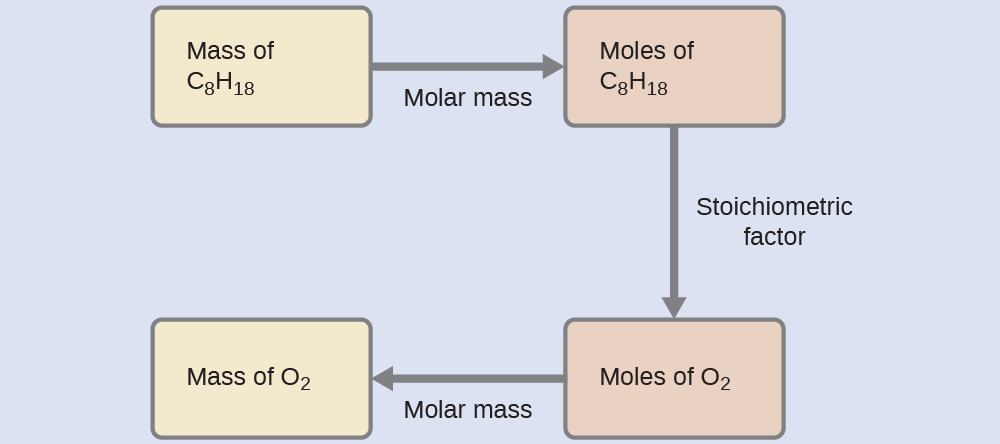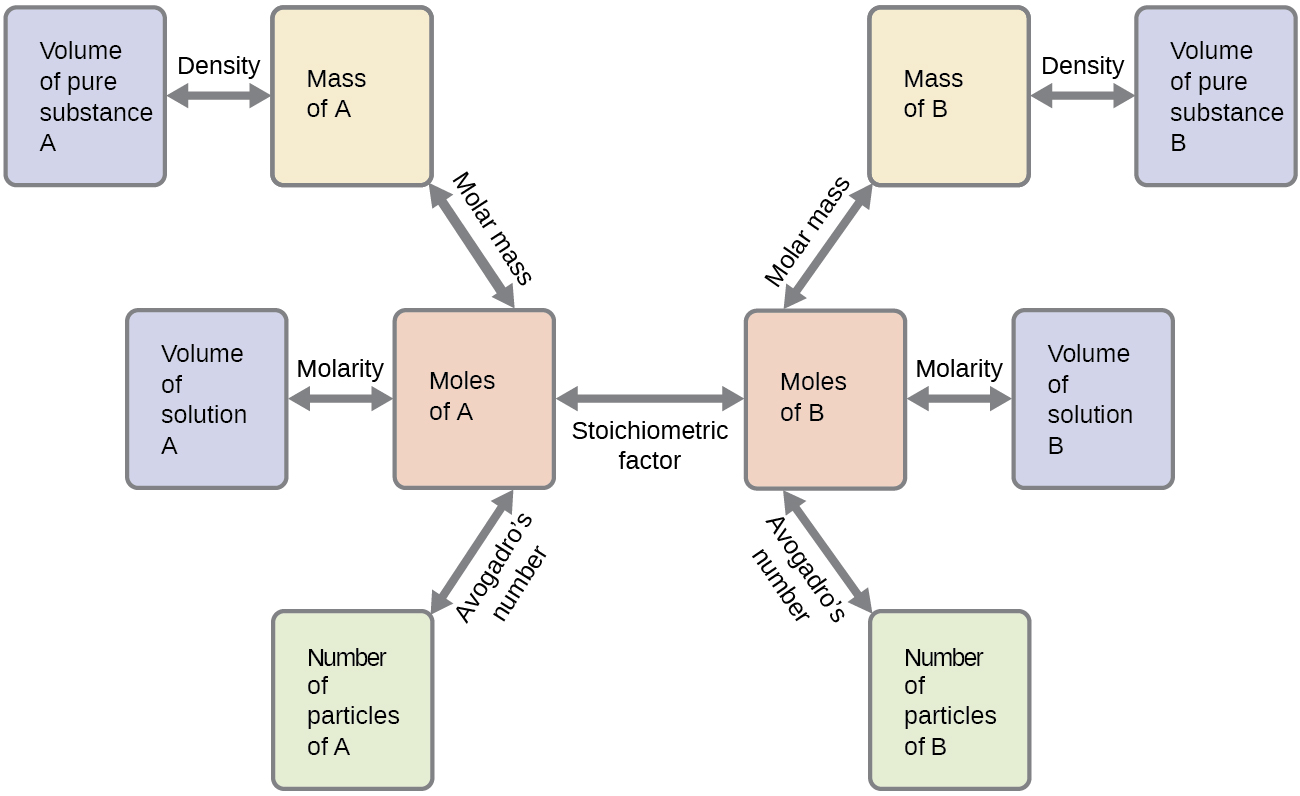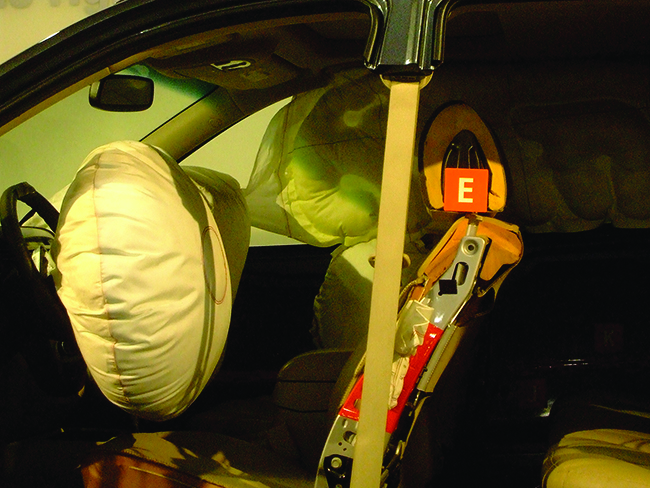what mass of naoh is required to react exactly with 25.0 ml of 1.2 m h2so4
Chapter iv. Stoichiometry of Chemical Reactions
4.3 Reaction Stoichiometry
Learning Objectives
By the end of this section, you will exist able to:
- Explain the concept of stoichiometry as information technology pertains to chemical reactions
- Use balanced chemical equations to derive stoichiometric factors relating amounts of reactants and products
- Perform stoichiometric calculations involving mass, moles, and solution molarity
A counterbalanced chemical equation provides a bang-up bargain of data in a very succinct format. Chemic formulas provide the identities of the reactants and products involved in the chemical change, allowing classification of the reaction. Coefficients provide the relative numbers of these chemical species, allowing a quantitative assessment of the relationships betwixt the amounts of substances consumed and produced by the reaction. These quantitative relationships are known as the reaction's stoichiometry, a term derived from the Greek words stoicheion (significant "chemical element") and metron (significant "mensurate"). In this module, the use of balanced chemical equations for various stoichiometric applications is explored.
The general approach to using stoichiometric relationships is similar in concept to the way people go nearly many common activities. Food grooming, for example, offers an advisable comparison. A recipe for making eight pancakes calls for i cup pancake mix, [latex]\frac{iii}{4}[/latex] cup milk, and i egg. The "equation" representing the preparation of pancakes per this recipe is
[latex]1 \;\text{cup mix} + \frac{three}{4} \;\text{cup milk} + 1 \;\text{egg} \longrightarrow 8 \;\text{pancakes}[/latex]
If two dozen pancakes are needed for a big family unit breakfast, the ingredient amounts must exist increased proportionally according to the amounts given in the recipe. For example, the number of eggs required to make 24 pancakes is
[latex]24 \;\rule[0.5ex]{4em}{0.1ex}\hspace{-4em}\text{pancakes} \times \frac{1 \;\text{egg}}{eight \;\rule[0.25ex]{3em}{0.1ex}\hspace{-3em}\text{pancakes}} = 3 \;\text{eggs}[/latex]
Balanced chemical equations are used in much the aforementioned fashion to determine the corporeality of one reactant required to react with a given amount of some other reactant, or to yield a given corporeality of product, and so along. The coefficients in the balanced equation are used to derive stoichiometric factors that permit ciphering of the desired quantity. To illustrate this idea, consider the production of ammonia past reaction of hydrogen and nitrogen:
[latex]\text{North}_2(g) + 3\text{H}_2(g) \longrightarrow 2\text{NH}_3(g)[/latex]
This equation shows ammonia molecules are produced from hydrogen molecules in a 2:three ratio, and stoichiometric factors may be derived using any amount (number) unit:
[latex]\frac{two \;\text{NH}_3 \;\text{molecules}}{3 \;\text{H}_2 \;\text{molecules}} \;\text{or} \;\frac{two \;\text{doz NH}_3 \;\text{molecules}}{iii \;\text{doz H}_2 \;\text{molecules}} \;\text{or} \;\frac{ii \;\text{mol NH}_3 \;\text{molecules}}{3 \;\text{mol H}_2 \;\text{molecules}}[/latex]
These stoichiometric factors can be used to compute the number of ammonia molecules produced from a given number of hydrogen molecules, or the number of hydrogen molecules required to produce a given number of ammonia molecules. Similar factors may exist derived for any pair of substances in any chemical equation.
Example 1
Moles of Reactant Required in a Reaction
How many moles of Iii are required to react with 0.429 mol of Al according to the following equation (see Figure ane)?
[latex]2\text{Al} + three\text{I}_2 \longrightarrow 2\text{AlI}_3[/latex]

Solution
Referring to the balanced chemic equation, the stoichiometric gene relating the 2 substances of involvement is [latex]\frac{3 \;\text{mol I}_2}{2 \;\text{mol Al}}[/latex]. The molar amount of iodine is derived by multiplying the provided molar amount of aluminum by this cistron:

[latex]\begin{array}{r @{{}={}} l} \text{mol I}_2 & 0.429 \;\rule[0.5ex]{3.25em}{0.1ex}\hspace{-iii.25em}\text{mol Al} \times \frac{three \;\text{mol I}_2}{2 \;\dominion[0.25ex]{2em}{0.1ex}\hspace{-2em}\text{mol Al}} \\[1em] & 0.644 \;\text{mol I}_2 \end{array}[/latex]
Check Your Learning
How many moles of Ca(OH)2 are required to react with 1.36 mol of H3PO4 to produce Caiii(POfour)2 co-ordinate to the equation [latex]3\text{Ca(OH)}_2 + 2\text{H}_3 \text{PO}_4 \longrightarrow \text{Ca}_3 \text{(PO}_4)_2 + 6\text{H}_2 \text{O}[/latex]?
Instance 2
Number of Product Molecules Generated by a Reaction
How many carbon dioxide molecules are produced when 0.75 mol of propane is combusted according to this equation?
[latex]\text{C}_3 \text{H}_8 + 5\text{O}_2 \longrightarrow 3\text{CO}_2 + 4\text{H}_2 \text{O}[/latex]
Solution
The arroyo hither is the same equally for Instance 1, though the absolute number of molecules is requested, not the number of moles of molecules. This will but require employ of the moles-to-numbers conversion factor, Avogadro's number.
The counterbalanced equation shows that carbon dioxide is produced from propane in a 3:i ratio:
[latex]\frac{3 \;\text{mol CO}_2}{ane \;\text{mol C}_3 \text{H}_8}[/latex]
Using this stoichiometric factor, the provided molar amount of propane, and Avogadro's number,

[latex]0.75 \;\dominion[0.5ex]{4.5em}{0.1ex}\hspace{-four.5em}\text{mol C}_3 \text{H}_8 \times \frac{3 \;\rule[0.25ex]{3em}{0.1ex}\hspace{-3em} \text{mol CO}_2}{ane \;\rule[0.5ex]{3em}{0.1ex}\hspace{-3em}\text{mol C}_3 \text{H}_8} \times \frac{6.022 \times 10^{23} \;\text{CO}_2 \;\text{molecules}}{\rule[0.25ex]{3em}{0.1ex}\hspace{-3em} \text{mol CO}_2} = 1.4 \times x^{24} \text{CO}_2 \;\text{molecules}[/latex]
Check Your Learning
How many NHiii molecules are produced past the reaction of iv.0 mol of Ca(OH)two according to the following equation:
[latex](\text{NH}_4)_2 \text{And so}_4 + \text{Ca(OH)}_2 \longrightarrow 2\text{NH}_3 + \text{CaSO}_4 + two\text{H}_2 \text{O}[/latex]
Respond:
4.8 × 1024 NH3 molecules
These examples illustrate the ease with which the amounts of substances involved in a chemical reaction of known stoichiometry may be related. Directly measuring numbers of atoms and molecules is, yet, not an like shooting fish in a barrel task, and the practical application of stoichiometry requires that we use the more readily measured holding of mass.
Example 3
Relating Masses of Reactants and Products
What mass of sodium hydroxide, NaOH, would exist required to produce 16 yard of the antacid milk of magnesia [magnesium hydroxide, Mg(OH)2] past the following reaction?
[latex]\text{MgCl}_2(aq) + 2\text{NaOH}(aq) \longrightarrow \text{Mg(OH)}_2(southward) + \text{NaCl}(aq)[/latex]
Solution
The approach used previously in Example 1 and Example 2 is as well used here; that is, nosotros must derive an appropriate stoichiometric factor from the balanced chemical equation and utilize it to relate the amounts of the two substances of interest. In this case, however, masses (non molar amounts) are provided and requested, so additional steps of the sort learned in the previous affiliate are required. The calculations required are outlined in this flowchart:

[latex]16 \;\rule[0.5ex]{5em}{0.1ex}\hspace{-5em}\text{g Mg(OH)}_2 \times \frac{1 \;\rule[0.25ex]{4.75em}{0.1ex}\hspace{-4.75em}\text{mol Mg(OH)}_2}{58.3 \;\rule[0.25ex]{3.5em}{0.1ex}\hspace{-3.5em}\text{g Mg(OH)}_2} \times \frac{two \;\rule[0.25ex]{3.5em}{0.1ex}\hspace{-three.5em}\text{mol NaOH}}{1 \;\dominion[0.25ex]{four.5em}{0.1ex}\hspace{-4.5em}\text{mol Mg(OH)}_2} \times \frac{40.0 \;\text{m NaOH}}{i \;\rule[0.25ex]{iii.25em}{0.1ex}\hspace{-3.25em}\text{mol NaOH}} = 22 \;\text{g NaOH}[/latex]
Bank check Your Learning
What mass of gallium oxide, Ga2O3, can be prepared from 29.0 m of gallium metal? The equation for the reaction is [latex]four \text{Ga} + three\text{O}_2 \longrightarrow two\text{Ga}_2 \text{O}_3.[/latex]
Example 4
Relating Masses of Reactants
What mass of oxygen gas, O2, from the air is consumed in the combustion of 702 g of octane, C8H18, one of the principal components of gasoline?
[latex]two\text{C}_8 \text{H}_{xviii} + 25\text{O}_2 \longrightarrow 16\text{CO}_2 + eighteen\text{H}_2 \text{O}[/latex]
Solution
The arroyo required here is the same every bit for the Example 3, differing but in that the provided and requested masses are both for reactant species.

[latex]702 \;\dominion[0.5ex]{3.5em}{0.1ex}\hspace{-3.5em}\text{g C}_8 \text{H}_{18} \times \frac{ane \;\rule[0.25ex]{three.5em}{0.1ex}\hspace{-3.5em}\text{mol C}_8 \text{H}_{18}}{114.23 \;\rule[0.25ex]{ii.75em}{0.1ex}\hspace{-2.75em}\text{g C}_8 \text{H}_{18}} \times \frac{25 \;\rule[0.25ex]{2.5em}{0.1ex}\hspace{-two.5em}\text{mol O}_2}{2 \;\rule[0.25ex]{3.5em}{0.1ex}\hspace{-three.5em}\text{mol C}_8 \text{H}_{18}} \times \frac{32.00 \;\text{m O}_2}{\rule[0.25ex]{2.5em}{0.1ex}\hspace{-2.5em}\text{mol O}_2} = 2.46 \times 10^iii \;\text{g O}_2[/latex]
Check Your Learning
What mass of CO is required to react with 25.13 yard of Fe2O3 according to the equation
[latex]\text{Fe}_2 \text{O}_3 + three\text{CO} \longrightarrow 2\text{Fe} + iii\text{CO}_2[/latex]
These examples illustrate but a few instances of reaction stoichiometry calculations. Numerous variations on the beginning and ending computational steps are possible depending upon what particular quantities are provided and sought (volumes, solution concentrations, and so forth). Regardless of the details, all these calculations share a common essential component: the use of stoichiometric factors derived from counterbalanced chemical equations. Figure 2 provides a full general outline of the diverse computational steps associated with many reaction stoichiometry calculations.

Airbags
Airbags (Effigy 3) are a safe feature provided in about automobiles since the 1990s. The effective operation of an airbag requires that it be rapidly inflated with an appropriate amount (volume) of gas when the vehicle is involved in a standoff. This requirement is satisfied in many automotive airbag systems through utilise of explosive chemic reactions, one common choice being the decomposition of sodium azide, NaNiii. When sensors in the vehicle detect a collision, an electric current is passed through a carefully measured amount of NaNiii to initiate its decomposition:
[latex]2 \text{NaN}_3(southward) \longrightarrow 3\text{North}_2(g) + 2\text{Na}(due south)[/latex]
This reaction is very rapid, generating gaseous nitrogen that can deploy and fully inflate a typical airbag in a fraction of a 2d (~0.03–0.ane s). Among many applied science considerations, the amount of sodium azide used must be advisable for generating enough nitrogen gas to fully inflate the air bag and ensure its proper function. For case, a pocket-size mass (~100 g) of NaN3 volition generate approximately 50 L of N2.

Key Concepts and Summary
A balanced chemical equation may be used to draw a reaction's stoichiometry (the relationships between amounts of reactants and products). Coefficients from the equation are used to derive stoichiometric factors that subsequently may be used for computations relating reactant and product masses, molar amounts, and other quantitative properties.
Chemistry End of Chapter Exercises
- Write the balanced equation, and then outline the steps necessary to determine the information requested in each of the following:
(a) The number of moles and the mass of chlorine, Cltwo, required to react with 10.0 thousand of sodium metal, Na, to produce sodium chloride, NaCl.
(b) The number of moles and the mass of oxygen formed by the decomposition of 1.252 thou of mercury(II) oxide.
(c) The number of moles and the mass of sodium nitrate, NaNO3, required to produce 128 1000 of oxygen. (NaNO2 is the other product.)
(d) The number of moles and the mass of carbon dioxide formed by the combustion of twenty.0 kg of carbon in an backlog of oxygen.
(due east) The number of moles and the mass of copper(II) carbonate needed to produce one.500 kg of copper(II) oxide. (CO2 is the other production.)
(f)

- Determine the number of moles and the mass requested for each reaction in Chemical science Finish of Chapter Exercise 1.
- Write the balanced equation, so outline the steps necessary to decide the information requested in each of the post-obit:
(a) The number of moles and the mass of Mg required to react with 5.00 thousand of HCl and produce MgCl2 and H2.
(b) The number of moles and the mass of oxygen formed past the decomposition of 1.252 g of silver(I) oxide.
(c) The number of moles and the mass of magnesium carbonate, MgCO3, required to produce 283 yard of carbon dioxide. (MgO is the other production.)
(d) The number of moles and the mass of water formed past the combustion of twenty.0 kg of acetylene, C2H2, in an excess of oxygen.
(e) The number of moles and the mass of barium peroxide, BaO2, needed to produce ii.500 kg of barium oxide, BaO (O2 is the other production.)
(f)

- Determine the number of moles and the mass requested for each reaction in Chemistry Cease of Chapter Exercise 3.
- H2 is produced past the reaction of 118.5 mL of a 0.8775-Thousand solution of H3POiv co-ordinate to the following equation: [latex]2\text{Cr} + 2\text{H}_3 \text{PO}_4 \longrightarrow iii\text{H}_2 + 2\text{CrPO}_4[/latex].
(a) Outline the steps necessary to decide the number of moles and mass of H2.
(b) Perform the calculations outlined.
- Gallium chloride is formed by the reaction of 2.half dozen L of a 1.44 Chiliad solution of HCl according to the following equation: [latex]two\text{Ga} + half dozen\text{HCl} \longrightarrow 2\text{GaCl}_3 + 3\text{H}_2[/latex].
(a) Outline the steps necessary to determine the number of moles and mass of gallium chloride.
(b) Perform the calculations outlined.
- I2 is produced past the reaction of 0.4235 mol of CuClii according to the post-obit equation: [latex]2\text{CuCl}_2 + 4\text{KI} \longrightarrow 2\text{CuI} + 4\text{KCl} + \text{I}_2[/latex].
(a) How many molecules of Iii are produced?
(b) What mass of I2 is produced?
- Silver is often extracted from ores such equally K[Ag(CN)2] and then recovered by the reaction
[latex]ii \text{K} [\text{Ag(CN)}_2](aq) + \text{Zn}(southward) \longrightarrow two\text{Ag}(s) + \text{Zn(CN)}_2(aq) + 2\text{KCN}(aq)[/latex](a) How many molecules of Zn(CN)2 are produced past the reaction of 35.27 g of Yard[Ag(CN)2]?
(b) What mass of Zn(CN)ii is produced?
- What mass of silver oxide, AgiiO, is required to produce 25.0 one thousand of silverish sulfadiazine, AgCtenH9N4Then2, from the reaction of silver oxide and sulfadiazine?
[latex]2\text{C}_{10} \text{H}_{10} \text{Due north}_4 \text{And so}_2 + \text{Ag}_2 \text{O} \longrightarrow 2\text{Ag} \text{C}_{10} \text{H}_{9} \text{Due north}_4 \text{And so}_2 + \text{H}_2 \text{O}[/latex] - Carborundum is silicon carbide, SiC, a very hard material used as an abrasive on sandpaper and in other applications. It is prepared past the reaction of pure sand, SiO2, with carbon at high temperature. Carbon monoxide, CO, is the other product of this reaction. Write the balanced equation for the reaction, and calculate how much SiO2 is required to produce 3.00 kg of SiC.
- Automotive air numberless inflate when a sample of sodium azide, NaN3, is very rapidly decomposed.
[latex]2\text{NaN}_3(south) \longrightarrow ii\text{Na}(due south) + three\text{N}_2(one thousand)[/latex]What mass of sodium azide is required to produce 2.vi ftthree (73.six L) of nitrogen gas with a density of i.25 g/L?
- Urea, CO(NH2)two, is manufactured on a large scale for apply in producing urea-formaldehyde plastics and as a fertilizer. What is the maximum mass of urea that tin be manufactured from the CO2 produced past combustion of 1.00×103kg1.00×103kg of carbon followed by the reaction?
[latex]\text{CO}_2(thou) + 2\text{NH}_3(k) \longrightarrow {\text{CO(NH}_2})_2(south) + \text{H}_2 \text{O}(l)[/latex] - In an accident, a solution containing ii.5 kg of nitric acrid was spilled. Ii kilograms of Na2COiii was quickly spread on the area and CO2 was released by the reaction. Was sufficient Na2CO3 used to neutralize all of the acrid?
- A compact car gets 37.5 miles per gallon on the highway. If gasoline contains 84.ii% carbon past mass and has a density of 0.8205 g/mL, determine the mass of carbon dioxide produced during a 500-mile trip (3.785 liters per gallon).
- What volume of 0.750 M hydrochloric acid solution tin be prepared from the HCl produced by the reaction of 25.0 thousand of NaCl with excess sulfuric acid?[latex]\text{NaCl}(due south) + \text{H}_2 \text{So}_4(l) \longrightarrow \text{HCl}(grand) + \text{NaHSO}_4(s)[/latex]
- What volume of a 0.2089 1000 KI solution contains plenty KI to react exactly with the Cu(NO3)2 in 43.88 mL of a 0.3842 M solution of Cu(NO3)2?[latex]ii \text{Cu(NO}_3)_2 + 4\text{KI} \longrightarrow 2\text{CuI} + \text{I}_2 + four{\text{KNO}_3}[/latex]
- A mordant is a substance that combines with a dye to produce a stable fixed color in a dyed fabric. Calcium acetate is used as a mordant. It is prepared by the reaction of acetic acid with calcium hydroxide.[latex]2\text{CH}_3 \text{CO}_2 \text{H} + \text{Ca(OH)}_2 \longrightarrow \text{Ca(CH}_3 \text{CO}_2)_2 + 2\text{H}_2 \text{O}[/latex]
What mass of Ca(OH)two is required to react with the acetic acrid in 25.0 mL of a solution having a density of 1.065 g/mL and containing 58.0% acerb acrid by mass?
- The toxic paint called white lead, Pb3(OH)two(COiii)two, has been replaced in white paints by rutile, TiOii. How much rutile (g) can exist prepared from 379 g of an ore that contains 88.three% ilmenite (FeTiOiii) by mass?[latex]two\text{FeTiO}_3 + 4\text{HCl} + \text{Cl}_2 \longrightarrow 2\text{FeCl}_3 + two\text{TiO}_2 + two\text{H}_2 \text{O}[/latex]
Glossary
- stoichiometric factor
- ratio of coefficients in a balanced chemical equation, used in computations relating amounts of reactants and products
- stoichiometry
- relationships between the amounts of reactants and products of a chemical reaction
Solutions
Answers to Chemical science Terminate of Chapter Exercises
2. (a) 0.435 mol Na, 0.217 mol Cltwo, fifteen.4 g Clii; (b) 0.005780 mol HgO, 2.890 × 10−3 mol O2, 9.248 × 10−2 g O2; (c) 8.00 mol NaNO3, 6.eight × 102 g NaNOiii; (d) 1665 mol COtwo, 73.3 kg CO2; (due east) 18.86 mol CuO, 2.330 kg CuCO3; (f) 0.4580 mol CtwoHfourBrii, 86.05 g C2HivBr2
4. (a) 0.0686 mol Mg, 1.67 g Mg; (b) 2.701 × 10−iii mol Otwo, 0.08644 g Oii; (c) 6.43 mol MgCO3, 542 g MgCO3 (d) 713 mol H2O, 12.eight kg HiiO; (due east) 16.31 mol BaOtwo, 2762 g BaOtwo; (f) 0.207 mol C2H4, five.81 g C2H4
6. (a) [latex]\text{volume HCl solution} \longrightarrow \text{mol HCl} \longrightarrow \text{mol GaCl}_3[/latex]; (b) 1.25 mol GaCliii, 2.2 × ten2 g GaCl3
eight. (a) 5.337 × ten22 molecules; (b) 10.41 g Zn(CN)ii
10. [latex]\text{SiO}_2 + iii\text{C} \longrightarrow \text{SiC} + 2\text{CO}[/latex], iv.50 kg SiO2
12. 5.00 × 103 kg
14. 1.28 × 10v one thousand CO2
16. 161.forty mL KI solution
18. 176 g TiOii
Source: https://opentextbc.ca/chemistry/chapter/4-3-reaction-stoichiometry/
0 Response to "what mass of naoh is required to react exactly with 25.0 ml of 1.2 m h2so4"
Post a Comment